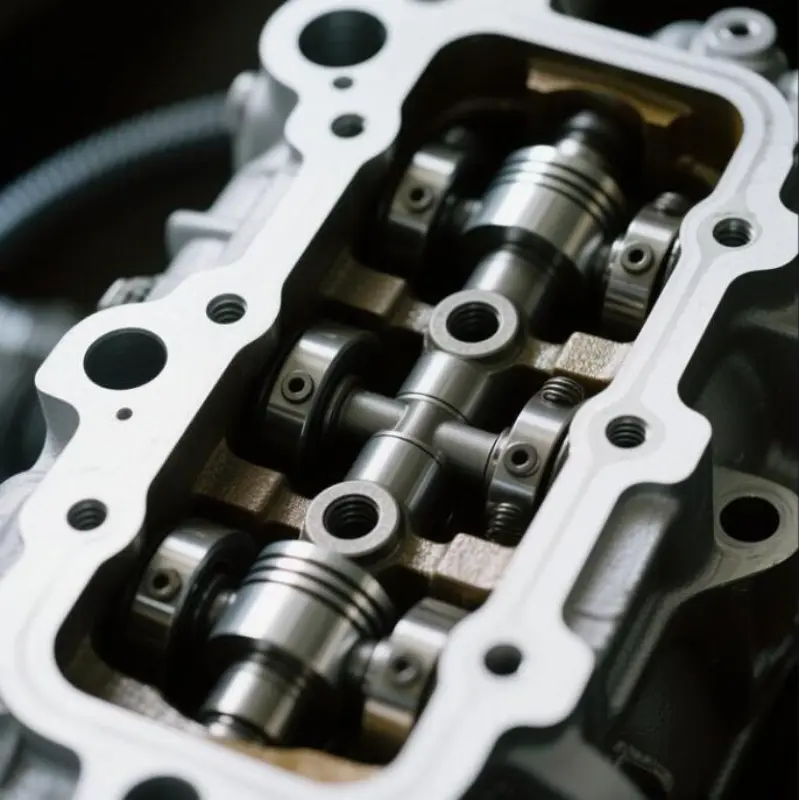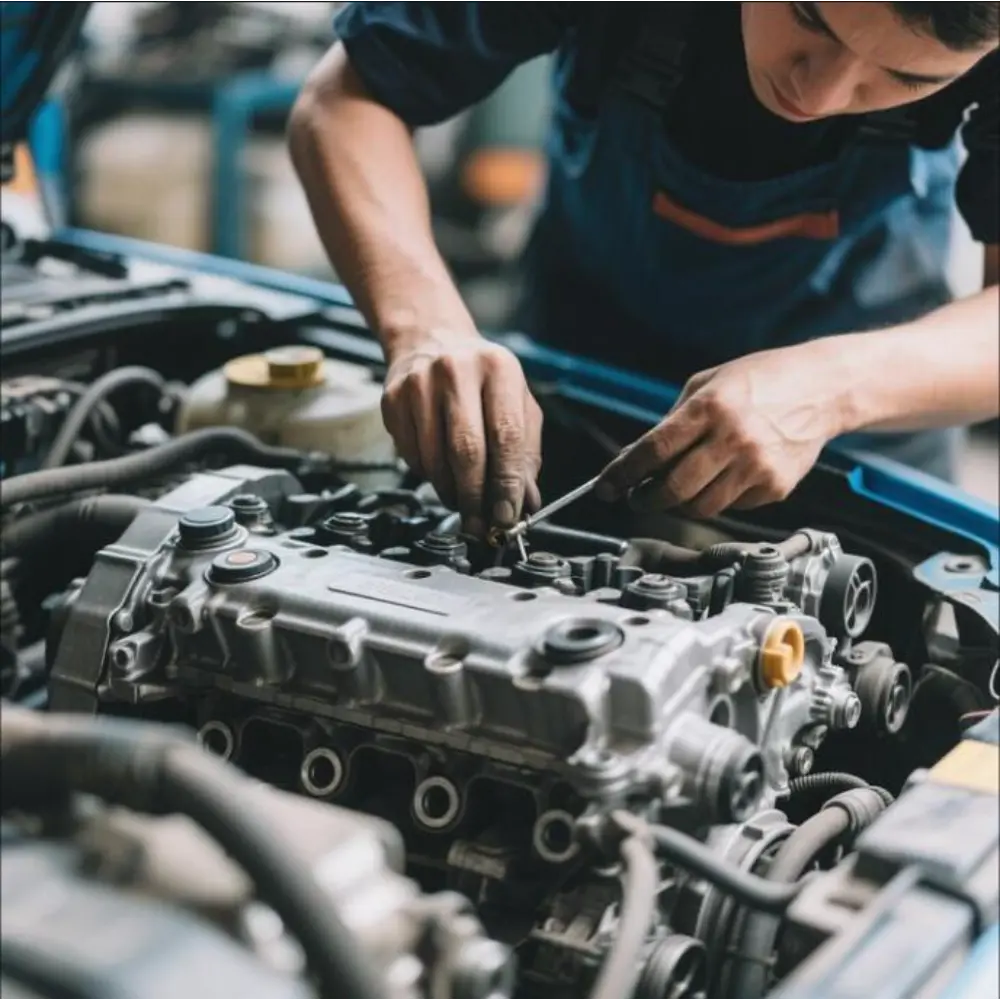Engine parts refer to the various components that make up an engine. They include pistons, cylinders, crankshafts, camshafts, valves, spark plugs, fuel injectors, oil filters, belts, and more. Each component plays a vital role in ensuring that the engine runs efficiently. Through this article, you can better understand these components and how they work.
Core Engine Parts
Cylinder Block
The cylinder block is the base of the engine. It holds key parts like cylinders, pistons, and the crankshaft. This block is usually made from strong iron or aluminum, which helps it handle heat and last longer. Think of it as the main frame, keeping everything connected.
Pistons
Pistons are vital for turning fuel into usable energy. They move up and down inside the cylinders, compressing the air-fuel mix and creating power to spin the crankshaft. Without pistons, the engine can’t produce energy.
Crankshaft
The crankshaft changes the pistons’ motion into spinning energy. This spinning energy powers wheels or other machinery. A well-made crankshaft helps the engine run smoothly and reduces shaking.
Connecting Rods
Connecting rods join the pistons to the crankshaft. They turn the pistons’ up-and-down motion into spinning energy. This energy powers the crankshaft, which moves the wheels or machinery. Without them, the engine can’t make usable energy.
These rods are made from tough materials like forged steel or aluminum alloys. This helps them handle high heat and strong forces inside the engine. Some high-performance engines use titanium rods for extra strength and less weight.
Note: Broken connecting rods can ruin the engine. If you hear knocking sounds, get it checked fast.

Camshaft
The camshaft helps the engine breathe by controlling the valves. It opens and closes the intake and exhaust valves at the right time. This ensures the engine gets air and fuel and removes exhaust properly. Without it, the engine won’t work well.
Tip: Check your camshaft often for damage or wear. A bad camshaft can hurt engine performance and waste fuel.
Here’s how the camshaft works:
The camshaft spins when the engine runs.
Its lobes press on valve lifters to move them.
This opens and closes the valves in sync with the engine.
A good camshaft keeps the engine running smoothly. Strange noises or poor performance may mean it needs checking.
Air and Fuel System Parts
The air and fuel system mixes air and fuel to create power. Your engine needs this system to run well. And every component in it helps improve performance and save fuel.
Intake Manifold
The intake manifold sends air to the engine’s cylinders. It makes sure each cylinder gets enough air to burn fuel.
Fuel Injectors
Fuel injectors spray fuel into the cylinders as a mist. This mist mixes with air for burning fuel. Accurate fuel spraying helps the engine run strong and cut pollution.
Throttle Body
The throttle body controls how much air goes into the engine. It works with the intake manifold to adjust airflow based on power needs. Pressing the gas pedal opens the throttle body for more air.
A clean throttle body helps the car speed up smoothly and saves fuel. Over time, dirt can build up inside and lower performance. Cleaning it often keeps it working right.
Air Filter
The air filter is an important part of the engine. It stops dirt, dust, and debris from getting inside. The air filter makes sure only clean air gets to the engine. This helps the engine work well and last longer. A dirty air filter can:
Use more fuel.
Make the engine weaker.
Cause more pollution.
Tip: Changing a dirty air filter can save up to 10% fuel.
Ignition and Electrical Engine Parts
The ignition and electrical system starts and powers the engine. These parts work together to ignite fuel and keep the engine running.
Spark Plugs
Spark plugs make sparks to ignite the air-fuel mix. Without them, the engine won’t start or make power. Each spark plug has a small tip that sparks when electricity passes through. This burns fuel more completely, cutting pollution and adding power. If your engine misfires or won’t start, check or replace the spark plugs.
Ignition Coil
The ignition coil changes the battery’s low power into high power. This high power makes the spark plugs work. A strong coil helps the engine burn fuel better and run faster.
Alternator
The alternator is an important part of a car’s electrical system. It makes electricity to run the car and charge the battery.
How Does the Alternator Work?
The alternator changes engine energy into electricity. A belt spins the rotor inside the alternator. This spinning creates a magnetic field that makes electricity. The electricity then goes to the battery and other car parts.
Features of a Good Alternator
Modern alternators are made to last and work well. Key features include:
| Feature | Benefit |
|---|---|
| High Output | Runs more devices easily |
| Durable Materials | Works well in tough conditions |
| Built-in Voltage Regulator | Stops the battery from overcharging |
Cooling and Lubrication Engine Parts
Radiator
The radiator helps cool the engine by removing heat. It moves heat from the coolant to the outside air. This stops the engine from overheating and getting damaged.
Water Pump
The water pump moves coolant through the engine and radiator. It makes sure all engine parts get cooled. Without it, the engine can overheat fast.
Research shows changing pump speeds can save fuel by 3%. It also cuts pollution and makes engines greener. Some systems use special nanoparticles in coolant to improve cooling and save energy.
Oil Pump
The oil pump spreads oil to engine parts under pressure. This reduces friction and stops parts from wearing out or overheating. A good oil pump helps the engine run smoothly and last longer.
Better oil pumps also improve fuel use. They lower friction, making the engine more efficient. Regular oil changes and pump checks keep the system working well.
Thermostat
The thermostat controls how hot or cold the engine gets. It keeps the engine warm enough to work well but cool enough to avoid damage.
How Does the Thermostat Work?
The thermostat works like a gate for coolant. When the engine is cold, it stays shut to warm it up faster. Once the engine is warm, it opens to let coolant flow and stop overheating.
Exhaust Engine Parts
Exhaust Manifold
The exhaust manifold gathers gases from the engine’s cylinders. It sends these gases into the exhaust system. This is the first step in removing harmful gases. Without it, gases would stay inside and hurt engine performance.
New exhaust manifolds are designed to better withstand high temperatures. They are usually made of heat-resistant and rust-resistant materials such as cast iron or stainless steel.
Oxygen Sensor
The oxygen sensor is a key part of the exhaust system. It checks how much oxygen is in the exhaust gases. This helps the engine control module (ECM) adjust the air-fuel mix. A good mix improves performance and cuts pollution. Without it, the engine may waste fuel or pollute more.

How to Care for Engine Parts
Regular maintenance is essential to keep engine components in good working order. Check your owner’s manual for recommended maintenance intervals and stick to your maintenance schedule. Change the oil and oil filter regularly, replace spark plugs and air filters as needed, and check belts and hoses for signs of wear or damage, etc. Regular maintenance can help avoid costly repairs later.
Benefits of Replacing Engine Parts
Replacing worn or damaged engine parts can improve engine performance, fuel efficiency, and overall reliability. It can also reduce emissions and extend engine life. In addition, upgrading to high-performance parts can increase horsepower and torque for a more enjoyable driving experience.
Engine parts are critical components to ensure your machinery runs smoothly. Understanding what engine parts are, how they work, and how to maintain and replace them can ensure your machinery remains reliable and efficient for years to come.

